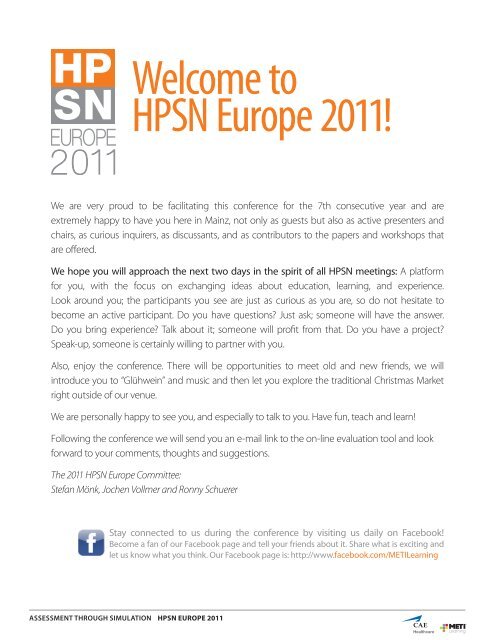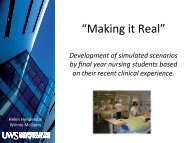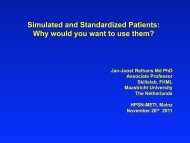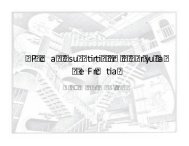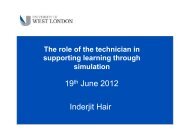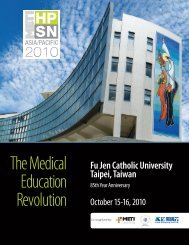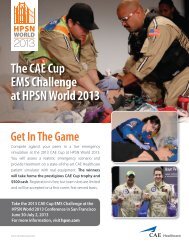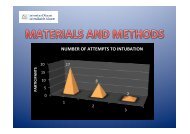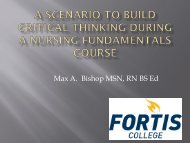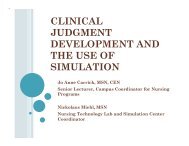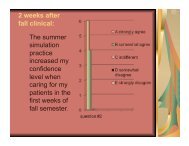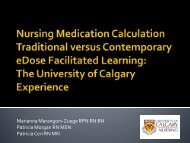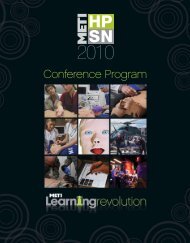Welcome to HPSN Europe 2011! - Human Patient Simulation Network
Welcome to HPSN Europe 2011! - Human Patient Simulation Network
Welcome to HPSN Europe 2011! - Human Patient Simulation Network
Create successful ePaper yourself
Turn your PDF publications into a flip-book with our unique Google optimized e-Paper software.
<strong>Welcome</strong> <strong>to</strong><br />
<strong>HPSN</strong> <strong>Europe</strong> <strong>2011</strong>!<br />
We are very proud <strong>to</strong> be facilitating this conference for the 7th consecutive year and are<br />
extremely happy <strong>to</strong> have you here in Mainz, not only as guests but also as active presenters and<br />
chairs, as curious inquirers, as discussants, and as contribu<strong>to</strong>rs <strong>to</strong> the papers and workshops that<br />
are offered.<br />
We hope you will approach the next two days in the spirit of all <strong>HPSN</strong> meetings: A platform<br />
for you, with the focus on exchanging ideas about education, learning, and experience.<br />
Look around you; the participants you see are just as curious as you are, so do not hesitate <strong>to</strong><br />
become an active participant. Do you have questions? Just ask; someone will have the answer.<br />
Do you bring experience? Talk about it; someone will profit from that. Do you have a project?<br />
Speak-up, someone is certainly willing <strong>to</strong> partner with you.<br />
Also, enjoy the conference. There will be opportunities <strong>to</strong> meet old and new friends, we will<br />
introduce you <strong>to</strong> “Glühwein” and music and then let you explore the traditional Christmas Market<br />
right outside of our venue.<br />
We are personally happy <strong>to</strong> see you, and especially <strong>to</strong> talk <strong>to</strong> you. Have fun, teach and learn!<br />
Following the conference we will send you an e-mail link <strong>to</strong> the on-line evaluation <strong>to</strong>ol and look<br />
forward <strong>to</strong> your comments, thoughts and suggestions.<br />
The <strong>2011</strong> <strong>HPSN</strong> <strong>Europe</strong> Committee:<br />
Stefan Mönk, Jochen Vollmer and Ronny Schuerer<br />
Stay connected <strong>to</strong> us during the conference by visiting us daily on Facebook!<br />
Become a fan of our Facebook page and tell your friends about it. Share what is exciting and<br />
let us know what you think. Our Facebook page is: http://www.facebook.com/METILearning<br />
ASSESSMENT THROUGH SIMULATION <strong>HPSN</strong> EUROPE <strong>2011</strong>
<strong>HPSN</strong> <strong>Europe</strong> Abstracts <strong>2011</strong><br />
Concurrent Session A<br />
Labora<strong>to</strong>ry Practices as Pedagogical Strategy<br />
and Critical Learning Environments<br />
José Amendoeira, Portuguese Catholic University,<br />
Santarém, Portugal<br />
Introduction: The emergence of inductive paradigms in higher<br />
education, the ability <strong>to</strong> think critically has been extensively<br />
studied (Simpson and Courtney, 2008; Standing, 2008), demonstrating<br />
its relevance in the field of individual student<br />
fac<strong>to</strong>rs, which may influence the clinical trial and clinical<br />
decision making. In this framework, we tried <strong>to</strong> understand<br />
how students learn <strong>to</strong> use critical thinking skills in Clinical Trial<br />
for learning of decision making, in the contexts of care.<br />
Method: Systematic Review of Literature (RSL) was used as the<br />
most appropriate strategy, formulating the question: Using<br />
Critical Thinking in Clinical Trial by nursing students in learning<br />
contexts of care facilitates decision-making clinical? We used<br />
the platform EBSCO (CINAHL Plus, Medline, Cochrane, Nursing<br />
and Allied Health Collection), using a pro<strong>to</strong>col, with filter<br />
2000/2010, submitting the following keywords in the<br />
sequence presented: Nursing Education, Critical Thinking,<br />
Clinical Judgement, and Decision Student Making.<br />
Results: Is relevant the importance of the combination of cognitive<br />
development and critical thinking, while contributions<br />
from the clinical examination and optimization of the processes<br />
of decision making in nursing. (Comer, 2005; Del Bueno, 2005;<br />
O’dells & Lisk, 2005; Standing, 2008; Horan, 2009; Guhde, 2010).<br />
Most notable are the use of simulation (Comer, 2005), in<br />
labora<strong>to</strong>ry settings, mini-scenes recreated using a simula<strong>to</strong>r<br />
(Horan, 2009), as strategies that facilitate those processes.<br />
Virtual Reality <strong>Simulation</strong> in Laparoscopic<br />
and Arthroscopic Surgery - Impact On Safety,<br />
Quality and the Quest for Young Talents<br />
Jörg Beardi, Schön Klinik Neustadt<br />
Quality management and Safety management systems become<br />
more and more important in hospitals and especially in the<br />
operating room. The successful improvement of flight safety<br />
and the lessons learned serves as a model for improvement<br />
of medical quality and patient safety. Two key points in flight<br />
training is the simulation training and implementation of<br />
check lists. Despite the developments in Quality and safety, the<br />
situation concerning the young academics is worsening<br />
because of a lack of students and the unattractive working<br />
situation in surgery for the generation Y. The aim of this<br />
presentation is <strong>to</strong> summarize the evidence based training<br />
effects of Virtual Reality <strong>Simulation</strong> Training, <strong>to</strong> summarize<br />
existing programs including own developments and <strong>to</strong> present<br />
the difficulties <strong>to</strong> generate a <strong>Simulation</strong> course. A short<br />
sight on future prospects concerning the quest for young<br />
academics and the contentment of the staff through implementation<br />
of simulation programs in<strong>to</strong> surgical curricula is given.<br />
Material and methods: The literature concerning VR-<strong>Simulation</strong><br />
in surgery has been reviewed. A pubmed search concerning<br />
VR <strong>Simulation</strong> and laparoscopic and arthroscopic surgery<br />
and simulation programs has been performed. Results and<br />
developed programs are compared. The international results<br />
of the implementation of the WHO pre-and-pos<strong>to</strong>perative<br />
checklist are compared presented. Own results on implementation<br />
of stress measurement and a intra-operative check list<br />
are presented. For the development of a training curriculum<br />
the results and experiences of the author are compared <strong>to</strong> the<br />
programs of the literature.<br />
Labora<strong>to</strong>ry Practices as Pedagogical Strategy<br />
José Amendoeira, Santarém Higher Health School,<br />
Santarém, Portugal<br />
In the context of nursing, labora<strong>to</strong>ry practices designed as<br />
pedagogical means reconciling theoretical knowledge with<br />
practical know-how. In Santarém Higher Health School -<br />
Portugal – develop them specifically in the context of<br />
Curricular Unit Nursing I and Stage I of the course of nursing –<br />
1st cycle, in the school context.<br />
Does Meti LearningSpace Offer Enough<br />
Space for Learning?<br />
Paul van Katwijk, Coördina<strong>to</strong>r of Professional<br />
Behavior and Clinical Internships, University of<br />
Twente, The Netherlands<br />
In this meeting Paul van Katwijk will elaborate on the didactical<br />
concept of skills training at Technical Medicine in the Netherlands.<br />
Training of skills as physical examination, communication,<br />
medical interview, writing medical files, reflection, but also skills<br />
as suture, inject, puncture, use of scope is based on a didactical<br />
concept in which the student is highly responsible for his own<br />
learning (deliberate practice). The assessment of skills is therefore<br />
more focused on awareness than on the actual performance<br />
of skills. The insight of the student on what he is doing,<br />
ASSESSMENT THROUGH SIMULATION <strong>HPSN</strong> EUROPE <strong>2011</strong>
whether he is capable of explaining his actions is thought <strong>to</strong><br />
be of more importance than <strong>to</strong> act according <strong>to</strong> pro<strong>to</strong>cols.<br />
How do we use MLS in relation <strong>to</strong> this didactical concept? MLS<br />
is a practical <strong>to</strong>ol for planning and registration. The question<br />
for this session is whether it also can be used as a real portfolio?<br />
A portfolio in which achievements are registered but is<br />
capable of directing the actual learning of the student <strong>to</strong>o?<br />
How flexible can MLS become? Are the students the users or<br />
the professors? Will it be possible <strong>to</strong> create a wide spectrum<br />
of assignments offered <strong>to</strong> the student based on the results of<br />
their assessments?<br />
Assessment – Real Time Performance Metrics<br />
Tim An<strong>to</strong>nius, University of Nijmegen,<br />
The Netherlands<br />
Technical skills (TS) are an essential part of daily medical<br />
practice. In complex emersive simulation sessions, technical<br />
skills are as important as the behavioral skills. TS evaluation<br />
during complex simulation sessions can be very difficult for<br />
the instruc<strong>to</strong>rs. Some skills require presence at the scene for<br />
proper evaluation because a lot of video systems are not<br />
capable <strong>to</strong> provide <strong>to</strong> instruc<strong>to</strong>r with enough detail or are<br />
difficult <strong>to</strong> control. Real time performance metrics (RPM)<br />
can provide the instruc<strong>to</strong>r with accurate data on the technical<br />
intervention. Data can be presented in such a way that<br />
the instruc<strong>to</strong>r can concentrate on other important tasks like<br />
behavioral skill rating, which technology in the current state<br />
fails <strong>to</strong> evaluate properly due <strong>to</strong> complex interpretation and<br />
communcation patterns. In this session we will explore the<br />
possibilities of RPM and demonstrate how it can be implemented<br />
using our new neonatal simula<strong>to</strong>r.<br />
Virtual Reality <strong>Simulation</strong> in Invasive<br />
Cardiology<br />
Wolfram Voelker, University of Würzburg,<br />
Germany<br />
Currently five virtual reality simula<strong>to</strong>rs for diagnostic procedures<br />
and percutaneous coronary interventions are available. <strong>Simulation</strong>-based<br />
education provides a realistic hands-on training<br />
comparable <strong>to</strong> flight simulation in aviation.<br />
However, for effective simula<strong>to</strong>r training in cardiology a<br />
dedicated teacher is manda<strong>to</strong>ry providing feedback and<br />
guidance. This trainer should be an experienced interventional<br />
cardiologist who knows both the simula<strong>to</strong>r and the selected<br />
training cases which serve as a vehicle for transferring<br />
knowledge and skills.<br />
Concurrent Session B<br />
Wireless Simula<strong>to</strong>rs<br />
Alin Schaumberg -<br />
University of Gießen, Germany<br />
Data and Statistical Output from <strong>Simulation</strong><br />
Sessions<br />
James Wilson, Lancashire <strong>Simulation</strong> Centre<br />
(LTHTR), UK<br />
We aim <strong>to</strong> demonstrate the range of statistics and data that is<br />
generated using StudioCode when ‘tagging’ events that occur<br />
during simulation. The poster/session will show the range of<br />
this data and how it can be used <strong>to</strong> debrief and its potential<br />
uses for assessment, with particular emphasis on timing and<br />
order of interventions<br />
Using The HPS <strong>to</strong> Make Complex Physiology<br />
Applicable in Clinical Practice<br />
Lex van Loon, University of Twente,<br />
The Netherlands<br />
In this presentation we will briefly explain how the HSP is used<br />
as part of the physiology education at the University of Twente<br />
in order <strong>to</strong> make complex physiology more applicable in<br />
clinical practice. Physiological control systems will be treated<br />
which are that underlie the HPS. Finally the use of the HSP<br />
as part of our Experimental Center of Technical Medicine is<br />
showed.<br />
Point of Care Ultrasound: Technology<br />
Spreading Faster than Expertise?<br />
Robert Amyot, University of Montreal,<br />
CAE Healthcare<br />
Content of the workshop: Ultrasonography in acute<br />
settings with targeted imaging is becoming a standard of<br />
care in medical centers as well as in the battlefield, in medical<br />
transportation, and <strong>to</strong> triage victims of mass casualties. Portable<br />
ultrasound systems are now low-cost, hand-carried devices<br />
generating reliable images. Moreover, these systems have<br />
been shown better than relying on landmarks <strong>to</strong> guide invasive<br />
procedures and therefore decrease complications. Unfortunately,<br />
most military and university medical centers do not<br />
have a structured environment <strong>to</strong> train healthcare providers <strong>to</strong><br />
develop scanning and pathology recognition skills. We must<br />
avoid a case of technology spreading faster than the expertise<br />
<strong>to</strong> use it. Participants will explore the capabilities of virtual reality<br />
<strong>to</strong> simulate a variety of acute pathologies that do not offer a<br />
realistic opportunity for practicing skills outside of a simula-<br />
ASSESSMENT THROUGH SIMULATION <strong>HPSN</strong> EUROPE <strong>2011</strong>
tion-based environment because of their emergent character.<br />
We will deploy ultrasonography simula<strong>to</strong>rs so that participants<br />
benefit from a hands-on experience. Educational and didactic<br />
considerations will be discussed with the participants as well.<br />
Concurrent Session C<br />
Sustaining <strong>Simulation</strong>-Based Programmes<br />
in Obstetrics<br />
Diogo Ayres de Campos, University of Por<strong>to</strong>,<br />
Portugal<br />
There is little scientific evidence <strong>to</strong> support the majority of<br />
simulation-based maternity training programmes, but some<br />
characteristics appear <strong>to</strong> be associated with sustainability.<br />
Among these are a clear institutional-level commitment <strong>to</strong> the<br />
course, strong leadership in course organisation, a curriculum<br />
relevant <strong>to</strong> clinical practice, a nonthreatening learning<br />
environment, the establishment of multiprofessional training,<br />
and the use of simula<strong>to</strong>rs appropriate <strong>to</strong> the learning<br />
objectives. There is still some debate on whether simulationbased<br />
sessions should be carried out in dedicated training<br />
time outside normal working hours or in ad-hoc drills that are<br />
run during clinical sessions, whether they should be located in<br />
clinical areas, simulation centres, or both, and whether or not<br />
they should include standardised generic teamwork training<br />
sessions.<br />
Assessing the Effectiveness of a <strong>Simulation</strong><br />
Course for Midwife Students<br />
Eszter Borjan, Semmelweis University Budapest,<br />
Hungary<br />
Each of the students at our Faculty has a compulsory course:<br />
clinical simulation. After this course we offer optional courses<br />
for nurse and midwife students using the most appropriate<br />
PNCI scenarios <strong>to</strong> prepare them for the real clinical practice.<br />
The METI <strong>Simulation</strong> Effectiveness Tool (SET) was used <strong>to</strong> assess<br />
the difference between the students’ opinion before and after<br />
the simulation course. The purpose of this presentation is <strong>to</strong><br />
illustrate our teaching strategies and our results using the SET.<br />
Innovative Add-on for Neuromuscular<br />
Moni<strong>to</strong>ring Using METIman<br />
Nuno Freitas, MEDSIMLAB, Portugal<br />
Presentation of an hardware and software add-on using<br />
METIman simula<strong>to</strong>r for neuromuscular response and<br />
moni<strong>to</strong>ring. Review of neuromuscular moni<strong>to</strong>ring standards<br />
and patient safety related issues.<br />
Matrix System Marking in <strong>Simulation</strong> Based<br />
Medical Education — The Basics<br />
James Wilson, Lancashire <strong>Simulation</strong> Centre<br />
(LTHTR), UK<br />
This workshop demonstrates the use of video capture and<br />
analysis in <strong>Simulation</strong> Based Medical Education, how it can be<br />
used <strong>to</strong> inform debrief and the basic of marking a simulated<br />
scenario.<br />
Augmented Reality: The Haptica Simula<strong>to</strong>r<br />
Fiona Slevin, CAE Healthcare<br />
The ProMIS Surgical Simula<strong>to</strong>r uses a unique blend of physical<br />
and virtual reality <strong>to</strong> provide a highly realistic, surgically relevant<br />
learning experience. It provides a range of training modules<br />
in general laparoscopic surgery and its technology has been<br />
extended <strong>to</strong> minimally invasive spine surgery. In a number of<br />
studies, ProMIS out-performed pure Virtual Reality (VR) in<br />
terms of validity and user preference.<br />
In this workshop-style presentation, participants will develop<br />
an understanding of ProMIS, the technology, current content<br />
(skills and procedural modules) and metrics. There will be<br />
special focus on how ProMIS provides an ideal <strong>to</strong>ol for research<br />
and for developing and integrating surgical skills curriculum.<br />
Concurrent Session D<br />
<strong>Simulation</strong> in Nurse Education: Nurse<br />
Educa<strong>to</strong>r Perceptions and Experiences<br />
Stella Whitley, Glyndwr University, UK<br />
This session discusses recent research with regards <strong>to</strong> how<br />
nurse educa<strong>to</strong>rs percieve simulation. There is much evidence<br />
<strong>to</strong> support simulai<strong>to</strong>n as a teaching modality and how students<br />
percieve simulation, however with the increasing popularity<br />
of simulai<strong>to</strong>n across the world it was of interest <strong>to</strong> explore<br />
the perceptions of nurse educa<strong>to</strong>rs prior <strong>to</strong> incorporating<br />
simulation in<strong>to</strong> the nursing curricula.<br />
Alternative <strong>to</strong> a Full Immersion <strong>Simulation</strong><br />
Suite<br />
Phani Kiran Yajamanyam, North Middlesex<br />
Hospital<br />
<strong>Simulation</strong> is increasingly becoming an essential part of junior<br />
doc<strong>to</strong>r training in the UK. It is now expected that all hospitals<br />
can deliver simulation training <strong>to</strong> foundation year doc<strong>to</strong>rs.<br />
We describe how effective high fidelity simulation can be<br />
implemented in a district general hospital without a dedicated<br />
simulation suite.<br />
ASSESSMENT THROUGH SIMULATION <strong>HPSN</strong> EUROPE <strong>2011</strong>
Design of Medical Simula<strong>to</strong>rs<br />
Willem van Meurs, CAE Healthcare<br />
• Provide insight in the structure and design of full-body<br />
model-driven acute care simula<strong>to</strong>rs.<br />
• Improve the dialog between simula<strong>to</strong>r users and designers.<br />
• Preliminary design of a new simula<strong>to</strong>r (component).<br />
After a brief introduction of the functional units of full-body<br />
model-driven simula<strong>to</strong>rs, and of embedded design procedures<br />
for simulations, simula<strong>to</strong>rs, and models, we will identify<br />
a medical training challenge that could be met by a new or<br />
an improved simula<strong>to</strong>r. A simple training needs analysis will<br />
be completed, a simulation based training program will be<br />
outlined, and simula<strong>to</strong>r requirements will be set.<br />
CAE Healthcare integrated <strong>Simulation</strong> Center<br />
Pedro Ramos, Madeira Clinical <strong>Simulation</strong><br />
Center, Funchal, Portugal<br />
The Practice of <strong>Simulation</strong>: A Contribution<br />
<strong>to</strong> Nursing Education<br />
Filipa Veludo, The Catholic University of Portugal,<br />
Lisbon<br />
The practice of simulation as a method of training is increasingly<br />
being used <strong>to</strong> train health professionals in various<br />
disciplines. In our context of training, this practice is integrated<br />
in the curriculum, using different scenarios, materials and<br />
resources, promoting the integration of knowledge, skill<br />
development, moni<strong>to</strong>ring of student learning.<br />
We emphasize the following objectives:<br />
Characterize the use of simulation in the labora<strong>to</strong>ry practice<br />
in curriculum<br />
Characterize the use of simulation as a methodology for<br />
evaluating<br />
Present aspects valued by students regarding the use of<br />
simulation in the learning environment.<br />
Concurrent Session E<br />
Simula<strong>to</strong>r Fidelity and Model Validity<br />
Willem van Meurs, CAE Healthcare<br />
• Present a framework for integrated design and evaluation of<br />
acute care simulations, simula<strong>to</strong>rs, and models.<br />
• Improve the dialog between simulation users and designers.<br />
In the context of full-mission simulation of high performance<br />
tasks we propose a framework for the integrated design and<br />
evaluation of acute care simulations, simula<strong>to</strong>rs, and models.<br />
In the design phase, we strive for functional fidelity, physical<br />
fidelity, and conceptual validity, respectively. <strong>Simulation</strong>,<br />
simula<strong>to</strong>r, and model designs can be evaluated via educational<br />
impact and clinical outcome studies, expert opinion, and<br />
conceptual validity, respectively. Challenges for design and<br />
evaluation include the relative nature of fidelity, the subjective<br />
nature of validity, and the scarcity of human target data for<br />
educationally relevant situations.<br />
Multidisciplinary Team (MDT) Training for<br />
Obstetric Emergency with Trauma<br />
James Wilson, Lancashire <strong>Simulation</strong> Centre<br />
(LTHTR), UK<br />
A presentation of a recent trauma scenario using a maternity<br />
simula<strong>to</strong>r. Eight different specialties were involved in managing<br />
the patient and associated injuries.<br />
<strong>Europe</strong>an Trauma Course 2009. Course Manual. Advanced<br />
Trauma Life Support Course manual. Robertson et al. <strong>Simulation</strong>-based<br />
crisis team training for multidisciplinary obstetric<br />
providers. <strong>Simulation</strong> Healthcare 2009.<br />
J-MANS - Our Experience in Creating a New<br />
Joint Training Course<br />
Ai-shi Lim, Sussex and Surrey NHS Trust, UK<br />
J-MANS stands for Joint Medical And Nursing <strong>Simulation</strong>.<br />
While the majority of simulation still involves only one discipline,<br />
more and more courses are beginning <strong>to</strong> harness the<br />
multidisciplinary aspect <strong>to</strong> simulation training. We share our<br />
s<strong>to</strong>ry of how we created a highly successful multidisciplinary<br />
training course from its inception <strong>to</strong> final product. It includes<br />
some advice on what we found helpful and things we wish<br />
we had avoided in trying <strong>to</strong> set up a multidisciplinary course<br />
such as J-MANS.<br />
ASSESSMENT THROUGH SIMULATION <strong>HPSN</strong> EUROPE <strong>2011</strong>
EndoscopyVR¨ - The Simula<strong>to</strong>r for<br />
Bronchoscopy and the Endoscopy of Upper<br />
and Lower GI Tract<br />
Friedrich Gauper, CAE Healthcare<br />
Like many other medical procedures endoscopy requires<br />
knowledge (ana<strong>to</strong>my, pathologies, use of the equipment),<br />
manual skills (inspecting the entire surface, performing the<br />
required interventions, without causing pain or severe<br />
damage, like perforation) and the appropriate attitude. While<br />
endoscopy used <strong>to</strong> be trained in the traditional ‘apprenticeship<br />
model’, the trainee watching what the trainer was doing<br />
and taking over step-by-step, the training object was still the<br />
patient, until virtual reality simula<strong>to</strong>rs have become available,<br />
that train the theoretical background (video tu<strong>to</strong>rials,<br />
animated graphics, etc.) and allow <strong>to</strong> simulate various procedures,<br />
from a simple bronchoscopy <strong>to</strong> an ultrasound guided<br />
trans-broncheal needle aspiration or from a straight forward<br />
EGD <strong>to</strong> a sophisticated ERCP, or performing pol-ypec<strong>to</strong>mies<br />
in the colon. Mistakes may occur, but these have in contrast<br />
<strong>to</strong> real life no consequence other than learning <strong>to</strong> do it better<br />
next time. There are various degrees of difficulties in the<br />
different cases and a very detailed post-simulation evaluation<br />
shows the performance relative <strong>to</strong> numerous pa-rameters<br />
and allows <strong>to</strong> moni<strong>to</strong>r the progress of the trainee. The CAE<br />
Healthcare Endo(scopy)VR will be shown in detail and anybody<br />
who has interest is invited <strong>to</strong> perform an endoscopic procedure.<br />
Neonatal Circulation Modeling<br />
Tim An<strong>to</strong>nius, Univ Nijmegen<br />
The fetal and neonatal circulation differs from the adult<br />
circulation in some very important aspects. The patent ductus<br />
arteriosus and foramen ovale in combination with the high<br />
pulmonary pressures makes right-<strong>to</strong>-left and left-<strong>to</strong>-right<br />
shunting of the blood an every day reality, which can be<br />
difficult <strong>to</strong> manage and understand. Current circula<strong>to</strong>ry models<br />
of adults don’t incorporate these physiologic shunts and<br />
therefore these models can not be used for teaching fetal and<br />
neonatal circula<strong>to</strong>ry (patho) physiology. Another important<br />
pathological feature of the neonatal circulation is the presence<br />
of congenital cardiac defects. These defects can also be<br />
very challenging <strong>to</strong> understand, even for seasoned neonatal<br />
intensivists.<br />
We improved and expanded a published model of the<br />
neonatal circulation and incorporated some common<br />
congenital heart defects. We also added an oxygen transport<br />
and bloodgas model. Learners can ‘tweak’ variables like shunt<br />
sizes, dimensions and other circula<strong>to</strong>ry parametes in real time<br />
and see what the effects are on the pressures, oxygenation<br />
and bloodgas.<br />
In this session we will explore the neonatal circula<strong>to</strong>ry model<br />
and discuss the way this learning <strong>to</strong>ol can be incorporated in<br />
clinical practice.<br />
Keynote<br />
Simulated and Standardized <strong>Patient</strong>s:<br />
Why Would You Want <strong>to</strong> Use Them?<br />
Jan-Joost Rethans, Associate Professor, Skillslab,<br />
Faculty of Health Medicine and Life Sciences,<br />
Maastricht University<br />
More than 45 years ago Barrows and Abrahamson introduced<br />
the use of simulated patients. A simulated patient (SP) is<br />
defined as a ‘normal person who has been carefully coached<br />
<strong>to</strong> accurately portray the characteristics of a specific patient’.<br />
Originally SPs were exclusively used in medicine but nowadays<br />
they are used in many other areas as for example in nursing,<br />
physiotherapy, dentistry, pharmacy, dietetics and veterinary<br />
medicine.<br />
Despite SPs long his<strong>to</strong>ry and it’s widespread use there are<br />
still many issues <strong>to</strong> be clarified or resolved in the use of SPs.<br />
Ignorance about the use of SPs leads <strong>to</strong> myths and fantasies<br />
about SPs, whereas in modern teaching one should focus on<br />
facts. Amongst the issues <strong>to</strong> be clarified or resolved in the<br />
use of SPs are: what is the difference between simulated and<br />
standardized patients?; are SPs only useful in the teaching of<br />
communication?; is feedback by SPs really useful?; how does the<br />
use of SPs compare <strong>to</strong> the use of real patients?; can all medical<br />
diseases be simulated?; How long does it really take <strong>to</strong> train an<br />
SP? and ‘SPs can only be used in small schools, isn’t it?’.<br />
In this presentation I will try <strong>to</strong> get rid of the myths, while<br />
beholding some fantasies (one must always have a dream!),<br />
but foremost I will focus on the facts and experiences about<br />
the use of SPs!<br />
The Use of Simula<strong>to</strong>rs in Military Aviation<br />
Bengt Littke, Senior Advisor, Gripen Marketing,<br />
Saab Aeronautics, Sweden<br />
Simula<strong>to</strong>rs have been used for training within the field of<br />
aviation for more than 60 years and are <strong>to</strong>day a natural and<br />
integral part of flight operations.<br />
The first simula<strong>to</strong>rs were designed <strong>to</strong> train instrument flying<br />
in general and instrument landing procedures in particular.<br />
ASSESSMENT THROUGH SIMULATION <strong>HPSN</strong> EUROPE <strong>2011</strong>
Today simula<strong>to</strong>rs are used <strong>to</strong> support training in almost every<br />
aspect of aviation, ranging from basic flying training, over aircraft<br />
type conversion <strong>to</strong> tactical training and mission rehearsal. You<br />
even find simulation functions embedded in the on-board<br />
computers, enabling the aircraft <strong>to</strong> give simulated responses<br />
<strong>to</strong> various pilot actions, like missile firing.<br />
A key feature in any simula<strong>to</strong>r is the cueing, meaning the<br />
responses given by the simula<strong>to</strong>r <strong>to</strong> the human senses in order<br />
<strong>to</strong> create a perceived realistic behaviour. In aviation the<br />
most important cues are visual, aural and motion cues. Fore<br />
some precision tasks, like formation flying, tactile cueing is<br />
also of importance. Absolutely accurate cueing is normally difficult<br />
<strong>to</strong> achieve, and it is often a very difficult assessment <strong>to</strong><br />
determine whether slightly unrealistic cues still adds value, or<br />
if they only increase the risk for negative training, i.e. when the<br />
student adopts a behaviour that is not the desired or intended.<br />
Another critical feature is the representation of abnormal situations<br />
or malfunctions. Although manufacturers often use<br />
the number of malfunctions represented in the simula<strong>to</strong>r as a<br />
selling argument, it is often a good strategy <strong>to</strong> focus on a few<br />
malfunctions that are either very common or leads <strong>to</strong> catastrophic<br />
results if not handled correctly. The risk is otherwise<br />
that the simulation of malfunctions becomes a cost driver,<br />
which is then seldom used in a training environment with<br />
strict curriculums and limited time.<br />
It is very important <strong>to</strong> distinguish the role of the user/cus<strong>to</strong>mer<br />
and the simula<strong>to</strong>r manufacturer. Only <strong>to</strong>o often you see the<br />
user designing the simula<strong>to</strong>rs, normally leading <strong>to</strong> poor and<br />
expensive products. Much preferred is a process where the<br />
user concentrates on the training needs, which are then, jointly<br />
by user and manufacturer, translated in<strong>to</strong> exact requirements<br />
in terms of simula<strong>to</strong>r response and cueing. These requirements<br />
are then in a second step translated in<strong>to</strong> a simula<strong>to</strong>r design.<br />
Tasks, which is a very detailed description the training needs.<br />
The other is a detailed description of simula<strong>to</strong>r behaviour in<br />
the form of a performance profile. Preferably every relevant<br />
aspect of the simula<strong>to</strong>r behaviour is described in a number<br />
of quantitative steps where a desired level of performance<br />
can be identified for every task. Based on this mapping you<br />
can decide whether you should have several simula<strong>to</strong>rs with<br />
different characteristics, or if it is more cost efficient <strong>to</strong> build<br />
one simula<strong>to</strong>r that can cover all the tasks. This analysis is<br />
normally referred <strong>to</strong> as the training media selection.<br />
In my presentation I will show a typical break down of military<br />
aviation training needs in<strong>to</strong> training tasks, as well as the<br />
typical content of a simula<strong>to</strong>r profile. I will also give examples of<br />
general classes of simula<strong>to</strong>rs or training media, and what types<br />
of training they are intended <strong>to</strong> support.<br />
Using Simula<strong>to</strong>rs <strong>to</strong> Perform High Stakes.<br />
Assessments: Lessons Learned From the UK<br />
FRCA Examinations<br />
Andrew McIndoe, Consultant Anaesthetist ,<br />
University Hospitals Bris<strong>to</strong>l NHS Foundation Trust,<br />
United Kingdom<br />
In 2004 the Examinations Committee of the Royal College<br />
of Anaesthetists decided <strong>to</strong> pilot the use of a commercially<br />
available full-body interactive patient simula<strong>to</strong>r as an<br />
Objective Structured Clinical Examination (OSCE) assessment<br />
station within the Primary Fellowship of the Royal College of<br />
Anaesthetists (FRCA) examination. This session discusses the<br />
results of that pilot and the subsequent formal inclusion of<br />
simula<strong>to</strong>r-based assessment in<strong>to</strong> the FRCA and wider medical<br />
curriculum.<br />
This leads in<strong>to</strong> the field of Training Needs Analysis, or TNA. The<br />
TNA consists of two parts. One is the definition of Training<br />
ASSESSMENT THROUGH SIMULATION <strong>HPSN</strong> EUROPE <strong>2011</strong>


